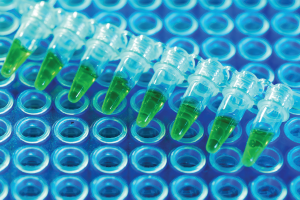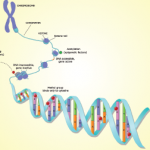
science photo/shutterstock.com
WASHINGTON, D.C.—Researchers have identified nine new genetic loci linked with juvenile idiopathic arthritis (JIA), along with evidence that at least some of them likely play a functional role, such as cytokine signaling and T cell expression.
The findings were presented in an abstract session at the 2016 ACR/ARHP Annual Meeting, which also included a presentation on findings on the epigenome in JIA.
Genetic Loci Linked to JIA
Researchers pooled 2,751 cases and 15,886 controls from cohorts previously studied, with an eye toward a large, homogeneous population.1 Many previous cohorts have included patients with all of the seven different subtypes of JIA. This cohort included only the similar oligo and rheumatoid factor-negative polyarthritis subtypes, said presenter Laura McIntosh, a graduate student and researcher at the Cincinnati Children’s Medical Center.
In their genome-wide association study, researchers found nine associated regions: JAK1, PRR9_LOR, PTH1R, ILDR1_CD86, FLJ41649, AHI1_LINC00271, HBP1, WDFY4 and RNF215. All had P values of at least 1 x 10(-6), suggesting significance, Ms. McIntosh said. None reached the threshold for genome-wide significance of 1 x 10(-8), but two came close: PRR9_LOR at 5.12 x 10(-8) and ILDR1_CD86 at 6.73 x 10(-8).
Some of these loci are already known to have relevance in immunology. JAK1 elicits signals from cytokines, such as interleukin (IL) 2 and IL-21, to induce IL-17 and IL-6 production. And CD86, which is expressed on antigen-presenting cells, causes stimulation of T cell-expressed CD28 and inhibition of T cell-expressed CTLA-4.
Four of the regions—JAK1, PTH1R, AHI1 and WDFY4—have been found to have roles in other autoimmune diseases, including celiac disease, multiple sclerosis and lupus. But five of the loci appear to be unique to JIA, Ms. McIntosh said.
To assess the functional implications of these loci, researchers queried two expression-quantitative trait loci (eQTL) databases to see whether any of them could affect the expression of their own genes or nearby genes. They found this to be the case for five of the loci.
“This lends to an important regulatory impact on these associated genes,” Ms. McIntosh said.
They also analyzed the single nucleotide polymorphisms (SNPs) for histone modifications in seven cells and found that “there’s evidence for a link between associated loci and potential functional consequences that could affect gene expression,” Ms. McIntosh said.
‘When you look at the histone marks, you see quite different epigenomes in patients with juvenile arthritis,’ Dr. Jarvis said. … ‘These [histone] marks were so significant that you could actually crisply sort out active disease from healthy controls both for K4 mono-methylation & K27 acetylation.’
Epigenetic Markers
In another JIA study, researchers found that neutrophils in children with the disease have epigenetic markers that aren’t seen in healthy children, and that the JIA neutrophil epigenome shows a high degree of plasticity, reorganizing over the course of therapy.2
They created a multidimensional genomic map of JIA using genome-wide methylation sequencing, RNA sequencing and chromatin immunoprecipitation-sequencing (ChiPseq) for histone marks (H3K4me1 and H3K27ac) in neutrophils. They assessed four patients with untreated, active disease; five with active, treated disease; and five healthy controls.
They also performed whole-genome sequencing on 48 patients with polyarticular, rheumatoid factor-negative JIA.
What they found in the patients with active, untreated disease was striking, said James Jarvis, MD, clinical professor of pediatrics at the University of Buffalo.
“When you look at the histone marks, you see quite different epigenomes in patients with juvenile arthritis,” he said. There were several areas with histone marks with higher peaks and others with loss of histone marks that would be expected.
“These marks were so significant that you could actually crisply sort out active disease from healthy controls both for K4 mono-methylation and K27 acetylation,” Dr. Jarvis said.
These “differentially enriched regions,” he said, were found mostly in intergenetic and intronic areas, not in areas with known genetic variants.
“We could account for only about 20% of the novel histone marks from these regions where we saw obvious genetic variants,” he said.
Treatment brought about changes, Dr. Jarvis said.
“When we treated patients with methotrexate, [we] quickly saw that regions that had shown gains—new histone marks in untreated disease—started to revert toward a pattern you would see in healthy patients,” he said, cautioning that it wasn’t a “correction,” but a move toward normalcy. “The changes in the histones correlated quite well with changes in transcription as we measured it by RNA sequencing.”
Researchers saw changes in methylation as well, once treatment was started, but did not notice clear links with gene transcription, he said.
“Clearly, there are changes in the methylation signature that [are] associated with treatment, but when you test regulatory potential of these altered regions, [we] didn’t see any particular association with gene transcription,” Dr. Jarvis said. “There’s a lot more to be learned about methylation in neutrophils. I think that in a small study like this there’s probably a subtle signature that you can’t see. But we can certainly say that treatment does alter methylation patterns in neutrophils.”
The findings show the apparent power of the environment in JIA, he said.
“Underlying genetic variance does not appear to be a strong driver of these novel epigenomes, consistent with a lot of new data coming out that the environment is a much stronger influence on transcription than underlying genetic variants,” Dr. Jarvis said. “These observations demonstrate the importance of understanding, I think, the function of the noncoding genome both for elucidating disease pathogenesis, [and] for understanding mechanisms of treatment response.”
Next steps, he said, should involve identifying all the functional regions within relevant cells—something he said is already underway—as well as identifying specific functional elements of this process, and ultimately building “network models” to understand how transcription is rewired in JIA treatment and testing genetic models in vitro.
Thomas R. Collins is a freelance writer living in South Florida.
References
- McIntosh L, Marion M, Sudman, et al. Genome-wide association analysis reveals novel juvenile idiopathic arthritis susceptibility loci [abstract 2032]. Arthritis Rheumatol. 2016;68(suppl 10).
- Jarvis J, Zhu L, Jiang K, et al. A multi-dimensional genomic map for polyarticular juvenile idiopathic arthritis [abstract 2033]. Arthritis Rheumatol. 2016;68(suppl 10).

